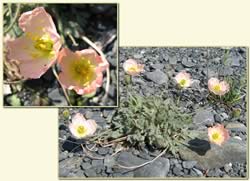Plant of the Week
 Range map of pale poppy in North America. The species is known only from Alaska, Yukon, British Columbia, and Kamchatka (Russian far-east).
Range map of pale poppy in North America. The species is known only from Alaska, Yukon, British Columbia, and Kamchatka (Russian far-east).
Pale Poppy (Papaver alboroseum Hultén)
By Robert L. DeVelice
Pale poppy is an uncommon and photogenic little plant. Its numbers are small enough that population viability is a concern and the USDA Forest Service in Alaska recognizes the species as “sensitive”. Because of its sensitive status, collection and disturbance of pale poppy is prohibited on the national forests of Alaska.
Pale poppies grow on open areas of sand and gravel on glacial outwash and flood plains and in rocky areas in tundra on ridges and mountain summits. On the Chugach National Forest it has been observed in scattered locations on the Kenai Peninsula and especially in the Portage and Bear valley area. The species is not very tolerant of competition with other plants and as the cover of competitors increases the occurrence of pale poppy decreases.
A distinguishing feature of the plant is the often striking white to pale pink flowers ("alboroseum" refers to the flower color). The plants grow in clumps, range in height from 2.5 to 7 inches, and have leaves divided into multiple segments.
To find pale poppy, visit the Begich Boggs Visitor Center in the Portage Valley of the Chugach National Forest. Specimens are planted in the native plant garden on the grounds of the Center.


